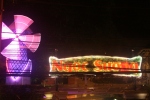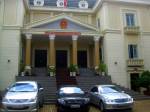Le Quy Don was an educator in 19th Century Vietnam so it is appropriate that the street named after him in Saigon is a major centre for educational institutions.
His name is pronounced “lay kwee (or “wee” depending on which part of the country you come from) don”. It is a short street in District 3. It is a street largely of education and eating, with schools and restaurants the length of the street.
Le Quy Don wrote historical, bibliographical, philosophical and encyclopaedic works. These included a 9 volume encyclopaedia, a 30 volume collection of historical documents, and 6 volumes on the lands of the Nguyen lords who ruled Vietnam during the 19th century when Le Quy Don lived.
He served as the rector of the national university in Hanoi, now widely known as the beautiful Temple of Literature, and is regarded as a great educator. Indeed these days his name is synonymous with education in Vietnam. Most cities have a street named after him, as are many educational institutions.
The street goes from Nguyen Thi Minh Khai, across Vo Van Tam and Dien Bien Phu, and stops at Vo Thi Sau. Le Quy Don school takes up an entire block on the corner of Le Quy Don and Nguyen Thi Minh Khai. It is regarded as one of the most prestigious schools in Saigon. It has been renovated in the last couple of years and looks splendid. It was established by the French in 1874 and was named after Rousseau until 1966 when the name was changed to that of the Vietnamese philosopher and encyclopaedist.
It is a beautiful building, with a large central quadrangle surrounded by cloisters and 2 stories of clasrooms. The pink walls and green shutters are topped by terracotta tiles. It has produced many famous and successful students, both within Vietnam and those who took refuge overseas.
On the corner with Vo Van Tan street, diagonally opposite the school, is the famous War Remnants Museum which is visited by tens of thousands of tourists who are quite oblivious to the charms of the school.
Le Quy Don school is not the only major school in the street. Further along is Marie Curie school, which is the only one in Saigon to have retained its French name. It was founded in 1918 by the French. During the Second World War it was turned into a Japanese hospital. It has gradually changed from being a private all-girls school to now being a mixed public school. It is a very large one, reportedly with 5000 students. It is one of the few that still offers French as a subject, and graduates get recognition for entry to several universities in major cities in France.
There are also 2 campuses of the Vietnam Australia International School, which is not related to the much better-known Australian International School and has nothing to do with Australia other than trading on the name. There is also a foreign language school, and at the end of the street a sports area for schoolkids. The area around this part of District 3 abounds with education, including several university buildings and many schools.
There are some other bits and pieces along the street – a court building, a very unusually-designed house, some office buildings, a large funeral building for the politically powerful – but the other major presence is restaurants. The most famous is Ngoc Suong, a large noisy seafood blast which should be on everyone’s to-do list in Saigon. There’s nothing quite like fresh scallops and tamarind crabs and whole ginger and soy fish washed down by a couple of Tiger beers to end the day, particularly when accompanied by the inevitable Filipino band playing Love Me Tender and Never on Sunday and other well-known traditional Vietnamese melodies.
- Fish tanks on the street so the fish can see you before you eat them
- Rstaurant and live music venue for all the trendy young Viets
- Nightclub sixteen with restaurant above
- Bright lights big city gone to my baby’s head
- Even in Saigon, there is still the local Thai restaurant
- Ngoc Suong – seafood extravaganza
- Au Manoir du Khai – expensive restaurant
- Interesting warning sign for a big pothole in the middle of a busy road at night.
- Hard at work in her street cafe
- I’m the police at the corner of Le Quy Don and Nguyen Th Minh Khai and you would think they would understand that I am in charge. Please pay attention.
- Local graffiti
- It’s hard work being a cyclo driver.
- I want this job. There are no urban railways.
- The street vendor texting.
- Law courts
- Every architectural style
- War Temnants Museum.
- Leaving school 8pm Saturday night. It wouldn’t happen in Sydney.
- Foreign language school.
- Marie Curie school
- The Vietnam Australia School
- Old house opposite LQD High
- Le Quy Don High School
- Le Quy Don statue at entry to school



























Hello, do you happen to have any pics of the old Abraham Lincoln Library, formerly at 8 Le Qui Don street, Quan 3, Saigon in the 1969 – 1970 time frame?
If you do, please kindly share it with me @ mermaidschaser@gmail.com
This week SpaceX Crew-1 mission to the International Space Station brings back nostalgic memories of the Apollo 11 Moon Landing exhibit in Sept 1969 at the Abraham Lincoln Library.
Many thanks !
Dan Le
Houston, TX, USA.
Hi. I can’t help unfortunately. I didn’t know there was a library there.